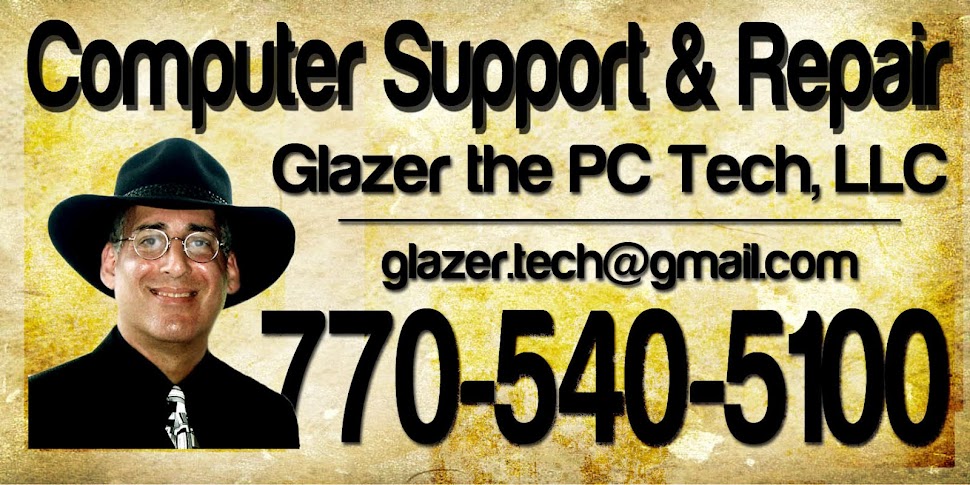|
Computer Care: Quick, easy steps to make your PC run smoother
In the Information Age, good information is good as gold. What follows, you could take to the bank. Don't deposit it. Cash it. Here are a bunch of quick tips, information you can use as soon as you finish reading it. This information is relevant, whether you have XP, Vista or Win 7. - Want to make shortcuts on your desktop of your webmail address or any address? Open your browser (Chrome, Firefox, Internet Explorer) and go to the page you want. Left-click on the icon to the left of the URL (address) and drag it to your desktop.
- Have too many miscellaneous icons on your desktop? Create folders to organize them. Right-click on an empty spot on your desktop and choose "new" and then "folder." Name it what you want. I have one for pdf files and one for utilities. Drag the respective icons into their new folders.
- Have trouble running programs sometimes? Right-click on the program icon from the desktop and choose to "Run as Administrator."
- To not corrupt data on your USB flash drives, don't just unplug them when you're done. In "My Computer," right-click on the USB drive and choose "Eject." Alternatively, go to the taskbar to use the "Safely Remove" option for USB devices. These turn the device off before you unplug it.
- Tired of Windows updates being thrown at you? Right-click on "My Computer' (or Computer) and go to "Properties."
- Find the Updates tab and choose another option. You can choose to have the system tell you when updates are available, but to download and/or install them when you want to.
- Back up often. It's not a matter of if a hard drive or another component will fail, but when. Save your data to an external source like another drive, a CD or DVD.
- Having trouble suddenly with things not being responsive? Try a System Restore. Find it in (XP) Programs -> Accessories -> System Tools or on Vista/7, just type it in the search box.
- Alternatively, press F8 when the system reboots and choose, "Return System to Last Known Good Configuration."
- Want to alphabetize your programs menu in XP? (It's automatically done in later versions.) Right-click on any entry on the list and choose to "Sort by name."
- Are your laptop keys not fully pressing down? Grab them with a finger nail and pull them off to dust underneath them. Then just press them back on until you hear a click. With desktop keyboards, turn them upsides down and shake, vacuum or use compressed air.
- Feel like your system is sluggish? See the processes list to determine which might be the culprit program. Press Control + Alt + Delete at the same time and see the Processes tab. If one has a very high number click on it, then choose "End Process." (Make sure it is not a system item or you'll just reboot.) If your system is better now, you have a found a resource hog program.
- If you don't have a lot of RAM (memory) in your computer, turn off the enhancements. In XP go to System Properties from My Computer again and choose "Advanced "and then "Settings". Choose the "Best Performance" option. In Vista/7, type, "fade" in the search box and turn off the superfluous enhancements. You really don't need animations, fade in and outs, transparencies, etc., especially if your RAM can't afford it.
- Remember to reboot your system after any changes are made for them to take effect. Also reboot when you install a new device (printer) or a new program.
- Pause or temporarily disable your antivirus program before you install new software. There is the potential for conflicts otherwise.
- If you lost sound, your Internet connection or anything, check the Device Manager for notification of a missing driver. In XP look under Hardware, from Properties in My Computer. In Vista/7, just type in the search area for Device Manager.
- This is more of an FYI than a tip: If you know you have a gigabyte of RAM but your system is showing only 704 megabytes, nothing is wrong. Your system is sharing memory with your video card. High-end cards come with their own RAM, others do not.
- When you install a printer, don't plug in your USB cable until the installation program tells you to do so. It probably won't work otherwise.
- When you get an error message, especially one you don't understand, Google it, in quotes if necessary to find out what's wrong.
- If you lose your Internet connection, try resetting your modem and router if you have one. You can wait on hold with your service provider for an hour and that is the first thing they will have you do.
There are so many things you can fix or enhance on your computer by yourself. But others do require a technician. Not everything is a do-it-yourself job. If you experiment in the Windows Registry for example, you can turn your computer into an expensive doorstop in a matter of seconds. Tread lightly. Arthur Glazer is a freelance writer and computer technician in Gainesville. His column appears biweekly. Arthur welcomes your computer questions and ideas for future columns |

No comments:
Post a Comment
Got a Comment - or a quick question...